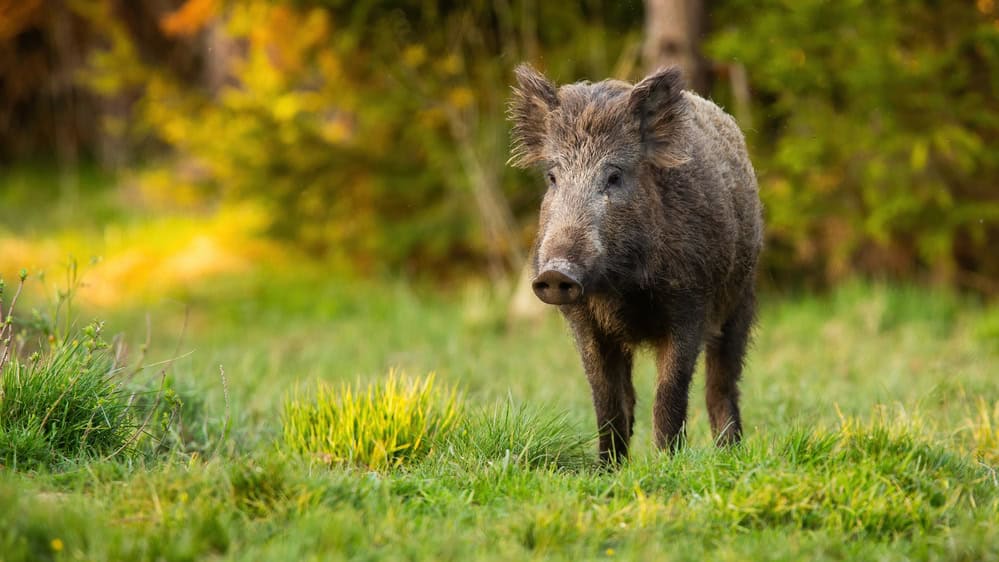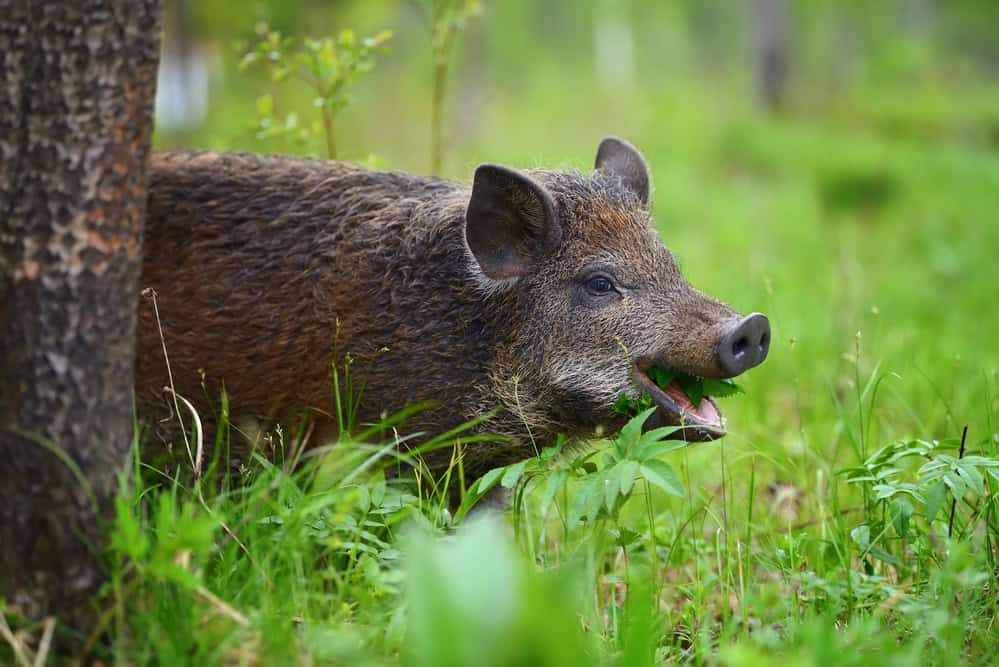When a 9-foot-long, 1,100-pound hog was killed in Fayette County, Georgia, it became a sensational story that rapidly spread across the globe. The unprecedented size of the hog captured the attention of major media outlets, creating a whirlwind of coverage that transcended borders.
A Global Media Frenzy

The enormous hog quickly became an international sensation, drawing the attention of media giants like CNN, Fox-5 News, and even the British Broadcasting Corporation (BBC). Reporters from across the United States, including those from local papers and radio stations in Seattle, Los Angeles, and Jacksonville, all reached out to Bill Coursey of Fayetteville, Georgia, for the story behind this record-breaking hog.
The Discovery

On the afternoon of January 4, around 3:30 PM, Bill’s wife and son were driving home in rural Fayette County when they spotted the massive black hog standing in a neighbor’s yard. The hog had emerged from a field, crossed the road, and was feasting on water-oak acorns. Intrigued by the sight, they pulled into the driveway for a closer look.
“The man who owns the property said, ‘If y’all want to shoot this thing, shoot it,’” recounted Bill. His son hurried home to fetch Bill, who returned with his Ruger 7mm/08 rifle.
The Hunt

“When we came around the corner, it just about blew me away when I saw the hog,” Bill said, describing his shock at the hog’s immense size. A seasoned hunter, Bill was astonished by the sheer magnitude of the animal. From 30 or 40 yards away, he aimed and fired a ballistic-tipped round behind the hog’s ear, causing the colossal creature to collapse instantly.
Aftermath of the Hunt

The aftermath of the hunt was nothing short of a spectacle. “After I shot it, it was like a circus around here,” Bill recalled. News of the enormous hog spread rapidly, attracting journalists and curious onlookers to his property. CNN, The New York Times, and various other media outlets sought to document the extraordinary event. People Bill had never met flocked to his home, eager to take pictures of the gigantic hog.
Weighing the Beast

Moving the hog proved to be a monumental task. The bucket of a backhoe was barely large enough to transport the hog, which was ultimately weighed at a county transfer station using truck scales. The process involved weighing the truck with the hog in the bed, then reweighing the truck without the hog. The final weight was a staggering 1,100 pounds, confirmed by a video statement from the scale operator and a printout of the weight.
Local Legend

The hog, characterized by its long coarse hair, broad shoulders, and enormous head, had been a local legend. “There was a lot of history of the hog around here,” Bill said. Numerous residents had spotted the hog and three others of similar size roaming a three- or four-mile radius near Brooks, Fayette County. The hogs had been seen for years, causing damage to properties along the way. One resident even thanked Bill, recounting how the hogs had uprooted all the sod around his newly built house.
A True Wild Boar

Despite its size suggesting some level of domestication, Bill believed the hog to be a true wild boar. The extraordinary size and features of the hog underscored its uniqueness and added to the legendary status of this Fayette County behemoth.
What Are Wild Boars?

Wild boars, also known as feral hogs or wild pigs, are a species of pig native to Eurasia and North Africa. They have been introduced to many other parts of the world, including the Americas and Australia, where they have become invasive species.
How Did Wild Boars Become Invasive?

Wild boars became invasive primarily due to human activities. They were introduced to new regions for hunting purposes and agriculture. Their ability to adapt and thrive in various environments has led to significant population growth in non-native areas.
What Do Wild Boars Eat?

Wild boars are omnivores with a diverse diet. They consume plants, roots, fruits, insects, small mammals, and carrion. Their feeding habits can cause extensive damage to crops and native vegetation.
How Fast Do Wild Boars Reproduce?

Wild boars reproduce rapidly, with sows capable of producing multiple litters per year. A typical litter consists of 4-6 piglets, but it can be as many as 12. This high reproduction rate contributes to their population explosion in many regions.
What Are the Physical Characteristics of Wild Boars?

Wild boars have stocky, muscular bodies covered in coarse hair. They have prominent tusks, sharp teeth, and a keen sense of smell. Adults typically weigh between 150-300 pounds, but some can exceed 400 pounds.
How Do Wild Boars Impact Agriculture?

Wild boars are highly destructive to agriculture. They root up fields, destroy crops, and damage irrigation systems. Their feeding and foraging behaviors can result in significant financial losses for farmers.
Are Wild Boars Dangerous to Humans?

Wild boars can be dangerous to humans, especially if they feel threatened. They are known for their aggressive behavior and can inflict serious injuries with their tusks. Encounters with wild boars should be approached with caution.
How Do Wild Boars Affect Native Ecosystems?

Wild boars disrupt native ecosystems by rooting and wallowing, which leads to soil erosion and the destruction of native plant communities. They also compete with native wildlife for food and can spread diseases.
What Diseases Can Wild Boars Transmit?

Wild boars can transmit various diseases to livestock, wildlife, and humans, including swine brucellosis, pseudorabies, and leptospirosis. These diseases pose significant health risks and can have economic impacts.
How Are Wild Boars Controlled?

Control methods for wild boars include trapping, hunting, and fencing. These methods aim to reduce their population and mitigate the damage they cause. Helicopter hunting and night hunting with thermal scopes are also used in some areas.
What Is the Economic Impact of Wild Boars?

The economic impact of wild boars is substantial, with estimates running into billions of dollars annually. This includes crop damage, livestock losses, and costs associated with disease control and management efforts.
How Do Wild Boars Adapt to Different Environments?

Wild boars are highly adaptable animals. They can thrive in various habitats, from forests and grasslands to agricultural areas and urban environments. Their adaptability makes them challenging to control.
What Are the Natural Predators of Wild Boars?

In their native range, wild boars have several natural predators, including wolves, tigers, and large birds of prey. However, in many of the regions where they are invasive, they have few natural predators, contributing to their population growth.
Can Wild Boars Be Domesticated?

While domestic pigs are descendants of wild boars, feral wild boars themselves are typically not domesticated due to their aggressive nature and the difficulty in controlling them. However, hybrids between wild boars and domestic pigs do occur.
Why Are Wild Boars Considered a Problem?

Wild boars are considered a problem due to their destructive behaviors, rapid reproduction, and adaptability. They cause extensive ecological and agricultural damage, spread diseases, and pose a threat to native wildlife and human safety. Managing their populations is a complex and ongoing challenge.
Conclusion

The story of the 1,100-pound hog shot by Bill Coursey is a remarkable tale of an unexpected encounter that captured the world’s attention. This extraordinary event not only highlights the impressive nature of wildlife in Fayette County but also underscores the powerful impact of media in spreading a story from a small town to a global audience.
Join our Forum for free today!

- Top 10 Reasons You Should Consider Adopting an Animal From a Shelter - June 17, 2024
- Massive 25-Foot Anaconda Halts Traffic in Brazil Caught on Camera - June 16, 2024
- Unique Footage of 5 Bald Eagles Fight Midair Over Unlucky Fish - June 16, 2024

